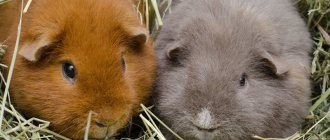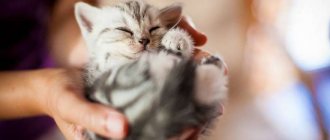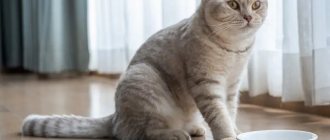The lifespan of cats exceeds the average lifespan of many domestic animals: the average cat, with proper care, can easily live up to 15 years, and some pets exceed the mark of 20 years. At the same time, no one can guarantee that your pet will live longer than 20 years. The decisive factors influencing life expectancy are nutrition, living conditions, and genetics also play a huge role. Thus, by choosing a pet from the breeds below, you increase the chance that it will live a very long cat life with you.
!Advice! In order for your pet to live as long as possible, feed your cat properly, vaccinate against the 3 most dangerous cat diseases and keep your purring cat at home - many pets die from injuries, dogs and poisoning with chemicals and poisons.
Siamese/Thai.
Siamese cats are a naturally formed breed that has attracted the attention of people since ancient times. She is known for her exotic coloring, as well as her loud voice and love of interacting with people. Some Siamese cats are prone to dental problems and respiratory problems, but otherwise the breed has no serious health problems. The average life expectancy is 15 to 20 years .
Burma.
The Burmese originated as a cross between a small brown-colored Burmese cat and a Siamese cat. This is a very playful, sociable and adventurous cat. Although the breed is generally healthy, it is predisposed to congenital deformities of the skull, as well as glaucoma. Despite these problems, the average Burmese life expectancy is between 16 and 18 years .
Savannah.
The Savannah is a cross between a serval and a domesticated cat and is only recommended for experienced owners. Even though Savannahs are not fully domesticated, they can make a great friend. But it must be remembered that they, as a rule, have an unpredictable, active and courageous character. This hybrid breed generally has no serious health problems and can live an average of 12 to 20 years .
How to extend the life of a pet?
A cat that has lived 16 years can be compared to a very elderly 80-year-old person. To increase the life expectancy of cats, you need to know and do several important things:
- Feed your pet correctly. It should be a balanced feed with essential nutrients, vitamins and minerals. Too fatty and salty food from the table will definitely not improve your cat’s health and will not prolong its life. But high-quality food will help keep your cat active and healthy for many years.
- It is imperative to check whether your pet has fresh water. Place several bowls of drinking water around the house. If possible, pamper your furry beauty with wet food.
- Keep bowls and trays clean. This preventive measure can prevent parasitic and infectious diseases, and can also help relieve your cat of unnecessary stress - cats love cleanliness. Remember that in a house where several cats live, each should have its own litter box and 1 additional one.
- Undergo routine examinations with a veterinarian and sterilize the animal. It is best to consult with a specialist about the most appropriate vaccination schedule, preventive treatments, and the desired age of sterilization. Spayed and neutered cats actually live longer because they are less likely to run away from their owners, less likely to get into fights with other animals, they have a lower risk of developing chronic viral infections (feline viral leukemia and feline viral immunodeficiency), and they have a lower risk of developing certain forms of neoplasms etc. And vaccinations and regular treatments against external and internal parasites help protect your pet from many diseases.
- Monitor the cat’s health, protect it from unnecessary stress associated, for example, with moving, repairs, and so on. Stress is an important factor in the development of urinary tract diseases in cats!
- Allow your cat to lead an active lifestyle. These animals are inquisitive and energetic, so any game is suitable for them: with a ball, mouse, feather, laser pointer. Houses, tunnels, passages, special shelves - all this stimulates your pet’s movements around the apartment. A cat that spends most of its time on the couch runs the risk of gaining excess weight, and so will others.
- Don't let her roam unattended. A domestic cat faces a lot of dangers on the street in the form of scattered rodent poison, dog attacks, or the risk of being hit by a car.
- Give a lot of attention and love. After all, the owners themselves can influence how many years cats live at home. Animals feel comfortable when they are petted, talked to and played with, without being scolded or punished.
Egyptian Mau.
Named after its country of origin (Mau is a cat in the language of Ancient Egypt), the Egyptian Mau is a beautiful cat with distinctive spots on its coat. These cats tend to be comfortable with people, making them an integral part of the family. While some are prone to heart problems, the average life expectancy of the breed is over 15 years .
Ragdoll.
Calm and well-mannered, the Ragdoll usually loves its owners and follows them everywhere. This breed also loves to lie for a long time in the arms of its owners. Ragdolls are a generally healthy breed, but some purrs are prone to bladder stones and heart disease. Despite this, the average lifespan of a ragdoll is more than 15 years .
Mitz Matz - 33 years old
It is possible that Mitz Matz would have lived longer if he had not been euthanized by mistake in Switzerland. The cat was considered the oldest representative of the “felines”; he lived for 33 years. Veterinarians euthanized him, mistaking him for a stray animal, although this was not the case. For a long time, this fluffy cat lived at the railway station in the Tegervilen commune - the station employees loved Mitz Matz, took care of him and fed him.
One day Mitz Matz decided to go for a walk outside the station - a woman passing by took the cat to the veterinarian, mistaking him for a stray. After examining the animal, the clinic specialist decided to euthanize the cat. The news came as a shock to those who cared for Mitz Matz. The veterinary hospital staff did not feel guilty, reporting that the cat was already very old: he could hardly see, his ears and teeth hurt.
Balinese cat (Balinese).
The Balinese cat probably arose from a spontaneous mutation in the Siamese, which resulted in the breed having long hair. Currently, the only significant difference between the two breeds is the length of the coat. Like Siamese, Balinese are friendly, energetic and love to “chat” with their owner. The pet always wants to be involved in the affairs of the house. The average lifespan of the breed is 12 to 20 years .
Russian blue.
The Russian Blue is a quiet and rather reserved cat that loves its family but does not like to be intrusive. She loves to relax in the sun or watch her domain from the highest point she can find. The breed is prone to developing bladder stones and is also susceptible to vision problems, but with proper care has an average lifespan of 14 to 20 years .
Bombay cat.
The Bombay cat was bred to look like a miniature panther, and breeders have generally been successful in achieving the desired appearance. These cats tend to have a calm and affectionate nature. They love to play, but they are also very happy when curled up in the lap of their loved one. The breed is prone to respiratory problems due to its short muzzle, as well as cardiovascular disease and excessive tearing. The average lifespan of the breed is about 16 years .
Mitz Matz - 33 years old
It is possible that Mitz Matz would have lived longer if he had not been euthanized by mistake in Switzerland. The cat was considered the oldest representative of the “felines”; he lived for 33 years. Veterinarians euthanized him, mistaking him for a stray animal, although this was not the case. For a long time, this fluffy cat lived at the railway station in the Tegervilen commune - the station employees loved Mitz Matz, took care of him and fed him.
One day Mitz Matz decided to go for a walk outside the station - a woman passing by took the cat to the veterinarian, mistaking him for a stray. After examining the animal, the clinic specialist decided to euthanize the cat. The news came as a shock to those who cared for Mitz Matz. The veterinary hospital staff did not feel guilty, reporting that the cat was already very old: he could hardly see, his ears and teeth hurt.
American Shorthair.
The American Shorthair, a breed originating from the common domestic shorthair cat in America, is popular among families with children due to its playful and calm nature. These cats tend to entertain themselves well and do not require much attention. But they also value socialization with their owner and playing together. Most of them do not have any general predispositions, but may be susceptible to heart disease. The breed has an average lifespan of 14 to 20 years .
Difficulty in care
Every cat requires grooming, but some breeds require more or less attention. Difficulty in content can both depress and delight - consider your desires and capabilities.
Cats that do not require special care
If you don’t want to spend your evenings combing wool or thinking about your pet’s menu, pay attention to the following breeds:
Short fur and sparse shedding
Cat for lovers of black clothes
Easy to care and maintain
Enough to feed and pet
Almost no shedding
Siamese cat
Suitable for even the laziest owner
This is an abbreviated list, but the easiest cats to care for are those with short hair and no quirks in appearance.
Long-haired cats often shed and require careful grooming, while hairless cats get cold and sweat. Pets with short hair are an excellent choice for a busy owner.
Difficult breeds to keep
Are you a passionate cat lover and ready to devote a considerable amount of time to caring for your pet? Then take a closer look at these breeds:
In winter it will never leave the battery
Freezes in the cold, sweats in the heat
A big cat has more fur
Thick fur sheds heavily
Lazy and fluffy
Scottish lop-eared
Curled ears need to be cleaned regularly
Sphynx cats are cold cats who want constant warmth and care. The Persian cat is complex due to its record length of fur, which constantly gets tangled into tangles. In addition, Persians have a flat face, which can cause them to get sick often.
It is not easy to care for cats with unusual ears: Scottish Fold or American Curls. Also, all long-haired breeds can be considered difficult-to-care cats.
Sphinx.
The Sphynx is a cat that requires increased costs and attention from its owner. Being hairless, cats of this breed often need clothing to keep them warm in cool weather. In addition, they should be washed frequently to remove traces of sweat from the skin. The breed is prone to heart disease, central nervous system and skin diseases. But with proper care, the average life expectancy will exceed 15 years .
The oldest two-headed cat
Perhaps we’ll also tell you about the oldest strange cat, which differs from its peers by having two heads! Such a unique long-liver was “Frank and Louis” (photo attached), who was euthanized this year due to the discovery of cancer at the age of 15, which is not at all typical for cats with such pathologies. Typically, kittens born with muzzle duplication do not live more than 4 days.
The unusual cat owes its life to a female veterinarian, Martha Stevens, who took him in as a newborn kitten from the clinic where the little miracle was brought to be put to sleep. Martha believes that everyone has the right to life, even if everyone has turned their back on them. The owner left “Frank and Louis” on her own, which took more than 3 months, because at first the kitten could not coordinate its movements and eat. The cat has two mouths and noses, three eyes, but, as experts have found out, there is only one brain. The cat from the American city of Worcester lived a long, happy life and took pride of place in the Guinness Book of Records as the oldest cat with two heads.











